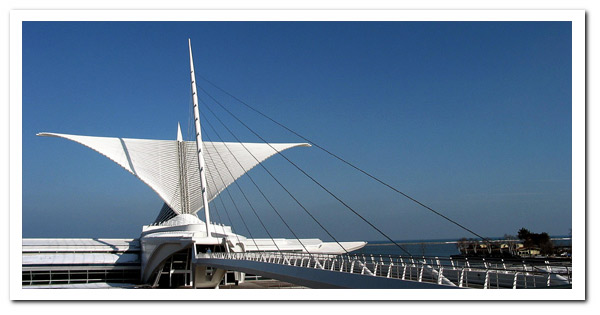The Walker is one of the country’s liveliest and most personable museums. It has been collecting shrewdly and imaginatively for the better part of a century. Of the several hundred works from its permanent holdings that make up its reopening suite of seven inaugural shows, many are being shown for the first time, and very few strike me as expendable. And now there is room for more.
Category: Architecture
Calatrava’s Milwaukee Art Musuem: Nocturnal Illumination?
As Calatrava projects go, this one is unusually subdued at night. His buildings and bridges in Spain, many of which I saw on a Calatrava-related odyssey in 2001, are beautifully lighted, sometimes theatrically so. His City of Arts and Sciences in Valencia, for example, becomes a charismatic town square at night, with an eyeball-shaped planetarium that gives off a lantern-like glow and a museum whose white ribcage looks even more dramatic than in the daytime. Calatrava himself designed the dramatic lighting for his cabled Alamillo Bridge in Seville (1992), its leaning-harp profile a forerunner of our own (well-lighted) 6th St. Viaduct, designed by Kahler Slater Architects.
Inspiration + Taking Risks + Execution = Calatrava’s Milwaukee Art Museum

A glorious view, worth the flight and/or drive. Visit. I continue to believe that this is a much, much better long term investment than Miller Park. Perhaps new Brewers principal owner Mark Attanasio can make something happen…. (Baseball downtown would have been so much better).
Tim Kelley: Kenton Peters on local politics & development
Tim Kelley summarized a recent letter on Madison’s downtown development trends from local developer Kenton Peters. [I’d like to link to it, but their articles go offline rather quickly]. Peters likely makes some useful points on the City’s “development process”, however, I for one, do not want to see another Peters building inflicted on the city. Peters’ federal courthouse (the blue silo version) and the WARF monster on University Avenue are surely more than sufficient eyesores. Background links: Alltheweb Clusty Google MSN TeomaYahoo Search
Overture Hall, Madison Symphony, James Trotter are all “Up to Date…”
James Oestreich on last weekend’s Symphony & organ performance:
The organ sounded splendid in Mr. Trotter’s performance of the Jongen work, though this is not quite so blatant a showpiece as, say, Saint-Sa?ns’s “Organ” Symphony (which the orchestra played in an earlier, prededication concert). The tonal qualities are rich and varied, and the sonic heft seems well suited to the space.
But it is crucial for a concert organ, as opposed to a church instrument, Mr. Trotter noted in conversation, to be able to blend with a symphony orchestra as well as stand up to it. And the blend here was uncanny, sometimes tricking the ear into confusing reed pipes with woodwind instruments.
But as good as all this news was, the crowning touch for an old Madison hand who arrived hopeful but not optimistic was the condition and quality of the Madison Symphony. At a time of orchestral retrenchment nationwide, this part-time group seems to be flourishing, with an annual surplus of $50,000 to $100,000 on its $2.8 million budget, and an endowment climbing toward $15 million. It added a third concert for 7 of its 9 subscription programs this season, and subscriptions and attendance are strong and rising steeply (partly, no doubt, because of the new hall).
It was indeed, an enjoyable evening. I agree with the writer that Madison is fortunate to have such a wonderful symphony.
Buffalo: Three “New” Frank Lloyd Wright Buildings!

Fred Bernstein on Buffalo’s plans to add three new Wright “inspired” buildings, in hopes of capturing more architectural tourists. (Monona Terrace is mentioned – along with comments on “executing” the designs of the long dead Wright:
Mr. Puttnam, 70, is best known for “executing” another Wright-designed building, a convention center in Madison, Wis., called Monona Terrace, which opened in 1997. Theodore Marks, the president of a nonprofit organization that hired Mr. Puttnam for one of the Buffalo projects – a boathouse on the Niagara River – described Monona Terrace as stunning.
Stunning perhaps, but not wholly accurate. “We used Wright’s exterior religiously,” Mr. Puttnam said, “except we made a six-inch mistake in height. There were hand-done drawings, and we thought we saw a zero. Years later we blew up the drawing for an exhibition, and we said, ‘Whoops, it’s not a zero, it’s a six.’ ”
Robert Twombly, a Wright biographer, has accused the architect’s former apprentices of muddying his legacy with mediocre “Wright” buildings.